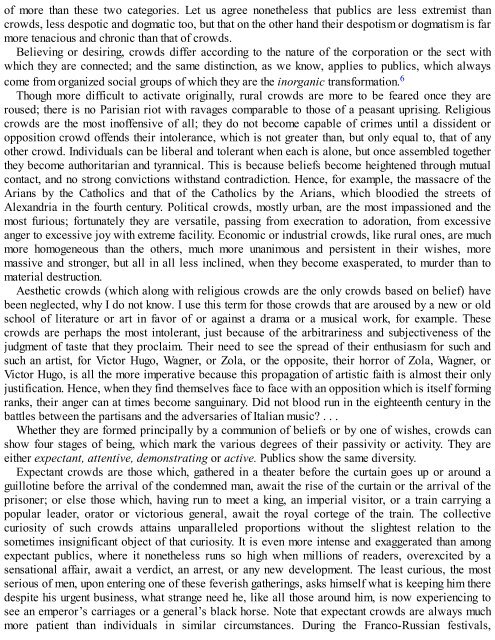3658925934
Create successful ePaper yourself
Turn your PDF publications into a flip-book with our unique Google optimized e-Paper software.
of more than these two categories. Let us agree nonetheless that publics are less extremist than<br />
crowds, less despotic and dogmatic too, but that on the other hand their despotism or dogmatism is far<br />
more tenacious and chronic than that of crowds.<br />
Believing or desiring, crowds differ according to the nature of the corporation or the sect with<br />
which they are connected; and the same distinction, as we know, applies to publics, which always<br />
come from organized social groups of which they are the inorganic transformation. 6<br />
Though more difficult to activate originally, rural crowds are more to be feared once they are<br />
roused; there is no Parisian riot with ravages comparable to those of a peasant uprising. Religious<br />
crowds are the most inoffensive of all; they do not become capable of crimes until a dissident or<br />
opposition crowd offends their intolerance, which is not greater than, but only equal to, that of any<br />
other crowd. Individuals can be liberal and tolerant when each is alone, but once assembled together<br />
they become authoritarian and tyrannical. This is because beliefs become heightened through mutual<br />
contact, and no strong convictions withstand contradiction. Hence, for example, the massacre of the<br />
Arians by the Catholics and that of the Catholics by the Arians, which bloodied the streets of<br />
Alexandria in the fourth century. Political crowds, mostly urban, are the most impassioned and the<br />
most furious; fortunately they are versatile, passing from execration to adoration, from excessive<br />
anger to excessive joy with extreme facility. Economic or industrial crowds, like rural ones, are much<br />
more homogeneous than the others, much more unanimous and persistent in their wishes, more<br />
massive and stronger, but all in all less inclined, when they become exasperated, to murder than to<br />
material destruction.<br />
Aesthetic crowds (which along with religious crowds are the only crowds based on belief) have<br />
been neglected, why I do not know. I use this term for those crowds that are aroused by a new or old<br />
school of literature or art in favor of or against a drama or a musical work, for example. These<br />
crowds are perhaps the most intolerant, just because of the arbitrariness and subjectiveness of the<br />
judgment of taste that they proclaim. Their need to see the spread of their enthusiasm for such and<br />
such an artist, for Victor Hugo, Wagner, or Zola, or the opposite, their horror of Zola, Wagner, or<br />
Victor Hugo, is all the more imperative because this propagation of artistic faith is almost their only<br />
justification. Hence, when they find themselves face to face with an opposition which is itself forming<br />
ranks, their anger can at times become sanguinary. Did not blood run in the eighteenth century in the<br />
battles between the partisans and the adversaries of Italian music? . . .<br />
Whether they are formed principally by a communion of beliefs or by one of wishes, crowds can<br />
show four stages of being, which mark the various degrees of their passivity or activity. They are<br />
either expectant, attentive, demonstrating or active. Publics show the same diversity.<br />
Expectant crowds are those which, gathered in a theater before the curtain goes up or around a<br />
guillotine before the arrival of the condemned man, await the rise of the curtain or the arrival of the<br />
prisoner; or else those which, having run to meet a king, an imperial visitor, or a train carrying a<br />
popular leader, orator or victorious general, await the royal cortege of the train. The collective<br />
curiosity of such crowds attains unparalleled proportions without the slightest relation to the<br />
sometimes insignificant object of that curiosity. It is even more intense and exaggerated than among<br />
expectant publics, where it nonetheless runs so high when millions of readers, overexcited by a<br />
sensational affair, await a verdict, an arrest, or any new development. The least curious, the most<br />
serious of men, upon entering one of these feverish gatherings, asks himself what is keeping him there<br />
despite his urgent business, what strange need he, like all those around him, is now experiencing to<br />
see an emperor’s carriages or a general’s black horse. Note that expectant crowds are always much<br />
more patient than individuals in similar circumstances. During the Franco-Russian festivals,









![Genki - An Integrated Course in Elementary Japanese II [Second Edition] (2011), WITH PDF BOOKMARKS!](https://img.yumpu.com/58322134/1/180x260/genki-an-integrated-course-in-elementary-japanese-ii-second-edition-2011-with-pdf-bookmarks.jpg?quality=85)
![Genki - An Integrated Course in Elementary Japanese I [Second Edition] (2011), WITH PDF BOOKMARKS!](https://img.yumpu.com/58322120/1/182x260/genki-an-integrated-course-in-elementary-japanese-i-second-edition-2011-with-pdf-bookmarks.jpg?quality=85)





